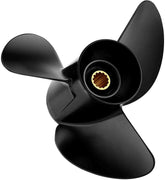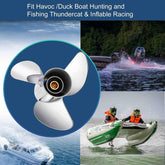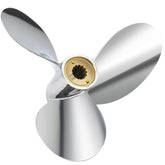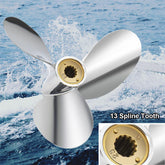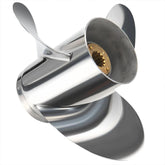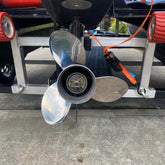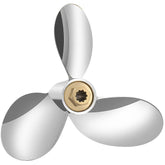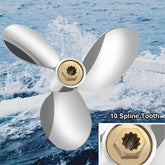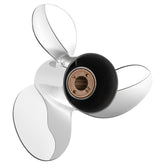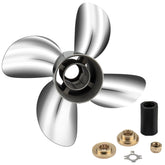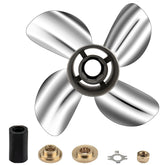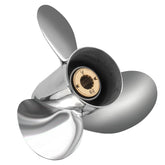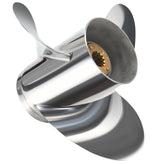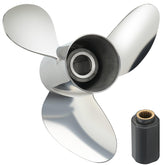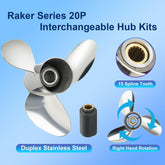Aluminum Propellers for Yamaha 50-130HP Outboard Motors
Understanding marine engine applications and selecting the right propeller are crucial steps in optimizing your boat's performance. This guide will delve into the engine specifications listed in the provided table, along with a detailed breakdown of OEM (Original Equipment Manufacturer) part numbers, propeller part numbers, and the key metrics required to choose the right propeller for different outboard motors.
Engine Applications Overview
The provided table lists the engine models that are compatible with specific propellers. Here’s a breakdown of the key engines and their specifications:
-
Engine Horsepower Range: 50HP to 130HP
-
Gearcase Size: 4-1/4 inches
-
Spline Tooth Count: 15 (with thru-hub exhaust)
Here’s a quick reference to the engines covered:
| Engine Model | Stroke Type | Year Range |
|---|---|---|
| T50 | 4-stroke | 1996 and newer |
| 60HP (C60/E60/P60) | 2-stroke | 1992-2005 |
| T60 | 4-stroke | 2003 and newer |
| 70HP | 2-stroke | 1984 and newer |
| F70 | 4-stroke | 2010 and newer |
| 75HP (C75/E75/P75) | 2-stroke | 1994-1999 |
| F75 | 4-stroke | 2003 and newer |
| F80 | 4-stroke | 1998-2002 |
| 85HP | 2-stroke | 1991-1997 |
| 90HP (C90) | 2-stroke | 1984 and newer |
| F90 | 4-stroke | 1999 and newer |
| F100 | 4-stroke | 1999-2002 |
| 115HP (C115/P115) | 2-stroke | 1984 and newer |
| F115 | 4-stroke | 2000 and newer |
| 130HP | 2-stroke | 1984-2003 |
Key Metrics for Propeller Selection
Selecting the right propeller requires understanding the following parameters:
1. Blade Count (B)
Blade count refers to the number of blades on a propeller. In the table, we see both 3-blade and 4-blade propellers. Generally, 3-blade propellers offer higher top speed, while 4-blade propellers provide better acceleration and handling.
2. Diameter (D)
The diameter of the propeller is the width of the circle made by the rotating blades. The table shows diameters ranging from 12.5 inches to 14 inches, with variations based on specific engine models and propeller designs.
3. Pitch (P)
Pitch is the distance a propeller would move in one revolution if there were no slippage. In the table, pitch values range from 9 inches to 23 inches. A higher pitch propeller moves more distance per rotation, providing higher top speed but lower acceleration.
Common Propeller Part Numbers
The table lists both OEM part numbers and their corresponding part numbers. Here’s a sample breakdown:
| OEM Part Number | Part Number | Blade Count | Diameter (D) | Pitch (P) | Code |
| 6E5-45943-00-EL | / | 3 | 12 5/8 | 21 | K |
| / | 3411-130-21 | 3 | 12 3/4 | 21 | R |
| 6E5-45941-00-EL | 3411-130-19 | 3 | 13 | 19 | K |
| 6E5-45945-01-EL | 3144-133-17 | 3 | 13 1/4 | 17 | K |
| 6E5-45958-00-00 | / | 3 | 13 1/2 | 14 | K |
| 6E5-45947-00-EL | 3411-135-15 | 3 | 13 1/2 | 15 | K |
| / | 3411-138-13 | 3 | 13 5/8 | 13 | R |
| / | 3411-135-15 | 3 | 13 3/4 | 15 | R |
| / | 3411-138-13 | 3 | 14 | 13 | R |
| 6E5-45954-00-EL | 3411-140-11 | 3 | 14 | 11 | K |
How to Use This Information
-
Verify Engine Compatibility: Make sure the engine model matches the propeller’s specifications.
-
Check Propeller Size and Pitch: Ensure that the diameter and pitch are suitable for your boating needs.
-
Understand the Part Numbers: Use the part numbers to order the right propeller from suppliers.
Conclusion
Choosing the right propeller can significantly improve your boat’s performance in terms of speed, fuel efficiency, and handling. The provided table offers valuable information to guide your selection process. By understanding the key metrics and part numbers, you can ensure that your propeller choice aligns with your engine's specifications, maximizing your boating experience.


